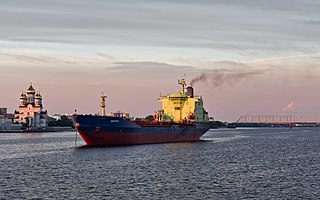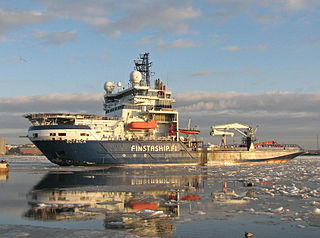
MSV Fennica is a Finnish multipurpose icebreaker and offshore support vessel. Built in 1993 by Finnyards in Rauma, Finland and operated by Arctia Offshore, she was the first Finnish icebreaker designed to be used as an escort icebreaker in the Baltic Sea during the winter months and in offshore construction projects during the open water season. Fennica has an identical sister ship, Nordica, built in 1994.

MT Alma is an Aframax crude oil tanker. Formerly known as Mastera for almost two decades and briefly as Mikines in early 2022, she and her sister ship Tempera were the first ships to utilize the double acting tanker (DAT) concept in which the vessel is designed to travel ahead in open water and astern in severe ice conditions. The icebreaking tanker was built to transport crude oil year-round from the Russian oil terminal in Primorsk to Neste Oil refineries in Porvoo and Naantali.

La Noumbi is a floating production storage and offloading (FPSO) unit operated by Perenco. The vessel, converted from the former Finnish Aframax crude oil tanker Tempera by Keppel Corporation, will replace an older FPSO unit in the Yombo field off the Republic of Congo in 2018.
SCF Sakhalin is a Russian icebreaking platform supply and standby vessel owned by SCF Sakhalin Vessels Limited, a subsidiary of Sovcomflot. The ship was built by Aker Finnyards Helsinki shipyard in Finland in 2005 as FESCO Sakhalin for Far East Shipping Company (FESCO), but was purchased by Sovcomflot and renamed in 2010. Since the beginning it has been in long-term charter for Exxon Neftegas Ltd. and used to supply oil platforms in the Sakhalin-I project.
Aker Arctic Technology Oy is a Finnish engineering company that operates an ice model test basin in Helsinki. In addition to ship model testing, the company offers various design, engineering and consulting services related to icebreakers, other icegoing vessels and arctic offshore projects as well as full scale trials, field expeditions and training for icy conditions. Formerly the arctic research centre of Wärtsilä and later Masa-Yards, Aker Arctic was established on 30 December 2004 as an independent company with Finnish Industry Investment Ltd, ABB and Aker Solutions as its current shareholders.

MT Indiga was an ice-strengthened product tanker that sailed under the Finnish flag in 1976–2003 and under the Russian flag in 2003–2021. After her modernization in 1994 she became the second merchant ship, after her sister ship Varzuga, to be equipped with an electric azimuth thruster called Azipod.

MT Varzuga was an ice-strengthened product tanker that sailed under the Finnish flag in 1977–2003 and under the Russian flag in 2003–2021. After her modernization in 1993, she became the first merchant ship to be equipped with Azipod, an electric azimuthing propulsion unit developed in Finland in the late 1980s. She was also the first non-Soviet ship to transit the Northern Sea Route.
A double acting ship is a type of icebreaking ship designed to run ahead in open water and thin ice, but turn around and proceed astern (backwards) in heavy ice conditions. In this way, the ship can operate independently in severe ice conditions without icebreaker assistance but retain better open water performance than traditional icebreaking vessels.

Arctech Helsinki Shipyard was a Finnish shipbuilding company that focused primarily on icebreakers and other icegoing vessels for arctic conditions.

MSV Botnica is a multipurpose offshore support vessel and icebreaker built by Finnyards in Rauma, Finland, in 1998. She was the newest and technically most advanced state-owned icebreaker of Finland until 2012, when she was sold to the Port of Tallinn for 50 million euro. Botnica is used as an escort icebreaker in the Baltic Sea during the winter months, but carries out subsea and offshore construction works worldwide during the open water season.

Vitus Bering is a Russian icebreaking platform supply and standby vessel owned by Sovcomflot. Built by Arctech Helsinki Shipyard in Helsinki, Finland, she and her sister ship, Aleksey Chirikov, were ordered on 16 December 2010, shortly after the joint venture agreement between STX Finland Cruise Oy and United Shipbuilding Corporation had been signed. Delivered to the owners on 21 December 2012, Vitus Bering will be used in the Arkutun-Dagi offshore oil field in the Sea of Okhotsk.
Arcticaborg (Арктикаборг) is an icebreaking platform supply vessel. She was previously operated by Wagenborg Kazakhstan in the Caspian Sea but was transferred to Canada in 2017 and acquired by Fathom Offshore in 2018. In 2019, she was contract to Russia for two years.
Georgiy Sedov is an icebreaking platform supply vessel operated by Rosmorport in the Sea of Azov. She was built by Kværner Masa-Yards in Helsinki, Finland, in 1998 as Antarcticaborg for Wagenborg Kazakhstan to be used in the Caspian Sea.

MSV Nordica is a Finnish multipurpose icebreaker and offshore support vessel. Built in 1994 by Finnyards in Rauma, Finland, and operated by Arctia Offshore, she and her sister ship Fennica were the first Finnish icebreakers designed to be used as escort icebreakers in the Baltic Sea during the winter months and in offshore construction projects during the open water season.
Aleksey Chirikov is a Russian icebreaking platform supply and standby vessel owned by Sovcomflot. She and her sister ship, Vitus Bering, were ordered on 16 December 2010 from Arctech Helsinki Shipyard in Helsinki, Finland, shortly after the joint venture agreement between STX Finland Cruise Oy and United Shipbuilding Corporation had been signed. Aleksey Chirikov was delivered on 19 April 2013. She will be used in the Arkutun-Dagi offshore oil field in the Sea of Okhotsk.

Baltika is a Russian icebreaker built by Arctech Helsinki Shipyard in Helsinki, Finland. She is the first ship ever built with an asymmetric hull that allows her to operate not only ahead and astern, but also obliquely (sideways) with a large angle of attack. In this way, the relatively small oblique icebreaker is capable of opening a wide channel in ice for large merchant ships.

Polaris is a Finnish icebreaker. Built in 2016 by Arctech Helsinki Shipyard, she is the most powerful icebreaker ever to fly the Finnish flag and the first icebreaker in the world to feature environmentally friendly dual-fuel engines capable of using both low-sulfur marine diesel oil (LSMDO) and liquefied natural gas (LNG). Polaris was initially ordered by the Finnish Transport Agency, but the ownership was transferred to the state-owned icebreaker operator Arctia after delivery.
Röthelstein is an Austrian river icebreaker owned by Verbund AG. She is used to break ice and push barges on the Danube river. Built by Kværner Masa-Yards in Finland in 1995, she was the first new vessel to be fitted with Azipod propulsion units.

Vyborg Shipyard PJSC is a shipbuilding company located in Vyborg, Russia. The company has a focus on icebreakers and other icegoing vessels for arctic conditions, but the company has also built deep sea semi-submersible floating drilling and production platforms for exploration of oil and gas offshore fields. Vyborg Shipyard employs more than 1,500 people.

Yuriy Kuchiev is an icebreaking gas condensate tanker operated by the Greek shipowner Dynacom. The vessel, built at Arctech Helsinki Shipyard in Finland, utilizes the double acting ship principle to allow independent operation without icebreaker escort in ice-covered seas. The vessel was delivered to the owner in August 2019.













